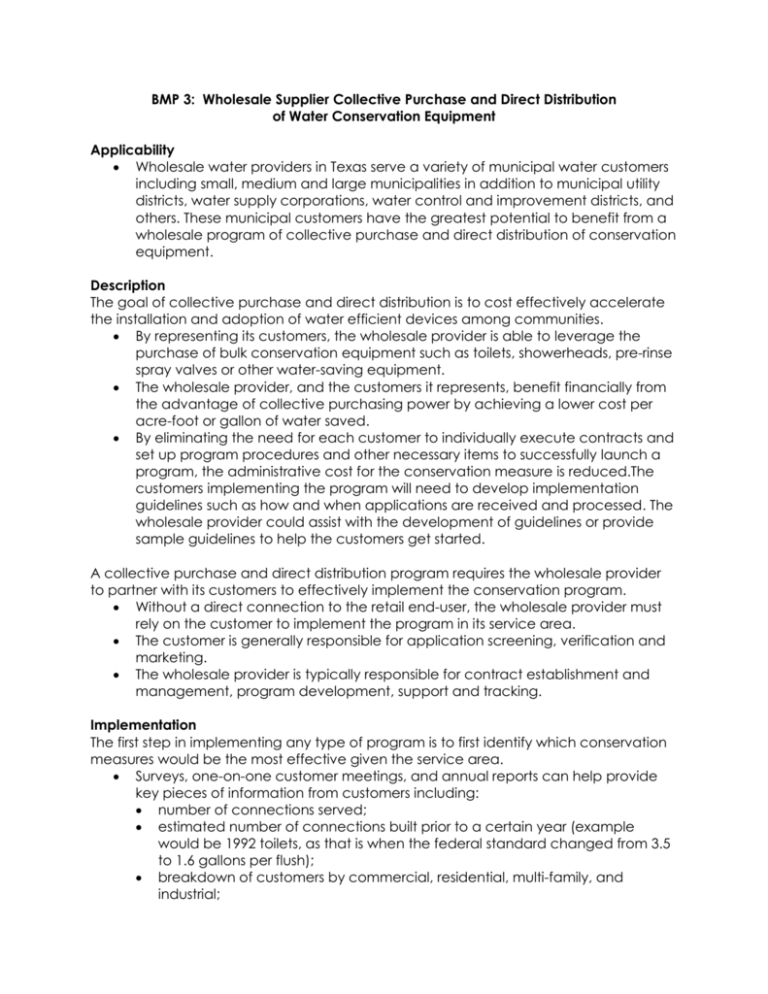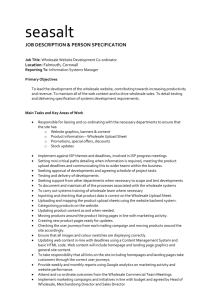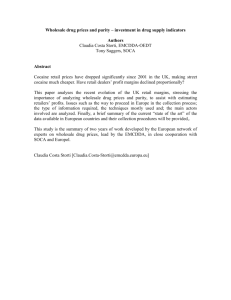Final Draft - Save Texas Water
advertisement

BMP 3: Wholesale Supplier Collective Purchase and Direct Distribution of Water Conservation Equipment Applicability Wholesale water providers in Texas serve a variety of municipal water customers including small, medium and large municipalities in addition to municipal utility districts, water supply corporations, water control and improvement districts, and others. These municipal customers have the greatest potential to benefit from a wholesale program of collective purchase and direct distribution of conservation equipment. Description The goal of collective purchase and direct distribution is to cost effectively accelerate the installation and adoption of water efficient devices among communities. By representing its customers, the wholesale provider is able to leverage the purchase of bulk conservation equipment such as toilets, showerheads, pre-rinse spray valves or other water-saving equipment. The wholesale provider, and the customers it represents, benefit financially from the advantage of collective purchasing power by achieving a lower cost per acre-foot or gallon of water saved. By eliminating the need for each customer to individually execute contracts and set up program procedures and other necessary items to successfully launch a program, the administrative cost for the conservation measure is reduced.The customers implementing the program will need to develop implementation guidelines such as how and when applications are received and processed. The wholesale provider could assist with the development of guidelines or provide sample guidelines to help the customers get started. A collective purchase and direct distribution program requires the wholesale provider to partner with its customers to effectively implement the conservation program. Without a direct connection to the retail end-user, the wholesale provider must rely on the customer to implement the program in its service area. The customer is generally responsible for application screening, verification and marketing. The wholesale provider is typically responsible for contract establishment and management, program development, support and tracking. Implementation The first step in implementing any type of program is to first identify which conservation measures would be the most effective given the service area. Surveys, one-on-one customer meetings, and annual reports can help provide key pieces of information from customers including: number of connections served; estimated number of connections built prior to a certain year (example would be 1992 toilets, as that is when the federal standard changed from 3.5 to 1.6 gallons per flush); breakdown of customers by commercial, residential, multi-family, and industrial; estimated number of automatic irrigation systems or a peak to average day water use ratio; and customer interest. These pieces of information will help steer program decisions on outdoor versus indoor and residential versus commercial conservation measures. Once the opportunities are identified, the wholesale provider can directly bulk purchase the equipment and distribute it to its customers or set up a voucher program for customers to offer to their end-users. o An example of bulk purchase with direct distribution would be a high efficiency showerhead program where the wholesale provider executes a contract for a bulk purchase of showerheads. The showerheads are then dropped off to the participating agency where they distribute them to their end-users. The number of showerheads distributed is reported to the wholesale provider for tracking purposes. o An example of a voucher program would be a high efficiency toilet (HET) program where the wholesale provider executes a contract for a bulk purchase of HET models. The participating customer partners with the wholesale provider to distribute the toilets through a voucher process. The customer collects and verifies applications from end-users and issues vouchers for the end-user to pick up toilets from the plumbing store under contract. The wholesale provider is billed by the contracted plumbing store and tracks the program. Prior to beginning the program, a legal agreement will need to be signed by the customer and the wholesale provider. This agreement will establish the roles and responsibilities of the two agencies. The agreement will also define the grounds for termination and other necessary information. The wholesale provider can also take on the role of developing program procedures and guidelines. This will help eliminate duplication of efforts and will reduce the overall administrative requirements for the program. Once standard templates are created for program applications, marketing materials, and other relevant documents, individual municipal customers can make slight modifications to the documents to effectively roll out the program in their service areas. Development of a web site that allows a customer to input information from an external location, while allowing wholesale provider to track equipment distributed provides an easy, effective way to monitor the distribution. When a web site is unavailable, the customer could also track the equipment distributed in a spreadsheet or other database and provide the information to the wholesale provider through periodic updates. Scope & Schedule Once collective purchasing opportunities have been identified, the following steps will need to occur. A contract or other bulk purchase of equipment by the wholesale provider. A customer agreement between the customer and wholesale provider, defining the roles and responsibility of each agency, will need to be drafted and signed by both parties. o These agreements typically go before a Board or Council so you need to allow time for management approval. A method of tracking will need to be developed. This could be an external Web site that both the customer and wholesale provider can access simultaneously or a stand-alone database that the customer maintains and periodically delivers to the wholesale provider. Program procedures and templates for the application, marketing pieces, frequently asked question documents and other materials that are necessary for the program to function effectively. Measuring Implementation and Determining Water Savings To track the progress of a collective purchasing program, the number of equipment items distributed should be carefully monitored to estimate water savings and track program costs. Cost-Effectiveness Considerations The majority of the cost will be determined by the type of equipment offered. Program administration costs will vary between customers and will also depend on the level and type of marketing the customer uses to advertise the program. References for Additional Information Lower Colorado River Authority Seattle Water Utility









